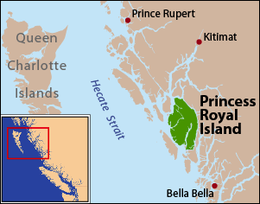Princess Royal Island

Princess Royal Island is located on the Inside Passage to the east of Hecate Strait
|
|
| Geography | |
|---|---|
| Location | North Coast Archipelago (Central Coast) |
| Coordinates | 52°55′N 128°50′W / 52.917°N 128.833°W |
| Area | 2,251 km2 (869 sq mi) |
| Administration | |
|
Canada
|
|
| Province | British Columbia |
| Region | North Coast |
| Demographics | |
| Ethnic groups | Tsimshian territory |
Princess Royal Island is the largest island on the North Coast of British Columbia, Canada. It is located amongst the isolated inlets and islands east of Hecate Strait on the British Columbia Coast. At 2,251 square kilometres (869 sq mi), it is the fourth largest island in British Columbia. Princess Royal Island was named in 1788 by Captain Charles Duncan, after his sloop, the Princess Royal.
The island is located in an extremely remote area of British Columbia, 520 kilometres (320 mi) north of Vancouver and 200 kilometres (120 mi) south of Prince Rupert. It is accessible only by boat or air. The Inside Passage ferry and shipping lane runs along its eastern flank, in Princess Royal Channel separating it from the mainland. The island is uninhabited, but used to be home to the community of Surf Inlet, a gold-mining town at the inlet of the same name (though also known as Port Belmont or Belmont), and Butedale, a mining, cannery, fishing and logging town on the island's east coast. The nearest communities today are Klemtu, on Swindle Island and Hartley Bay, on the mainland shore east of Gil Island.
Indian reserves on or adjacent to Princess Royal Island are:
Twelve of the 17 crew of U.S. Air Force 44-92075 were found alive here in 1950, during the first lost nuclear/Broken Arrow episode of the Cold War. The plane itself flew north after the crew bailed out, crashing on Mount Kologet, east of the Nass River to the northwest of Hazelton.
...
Wikipedia
